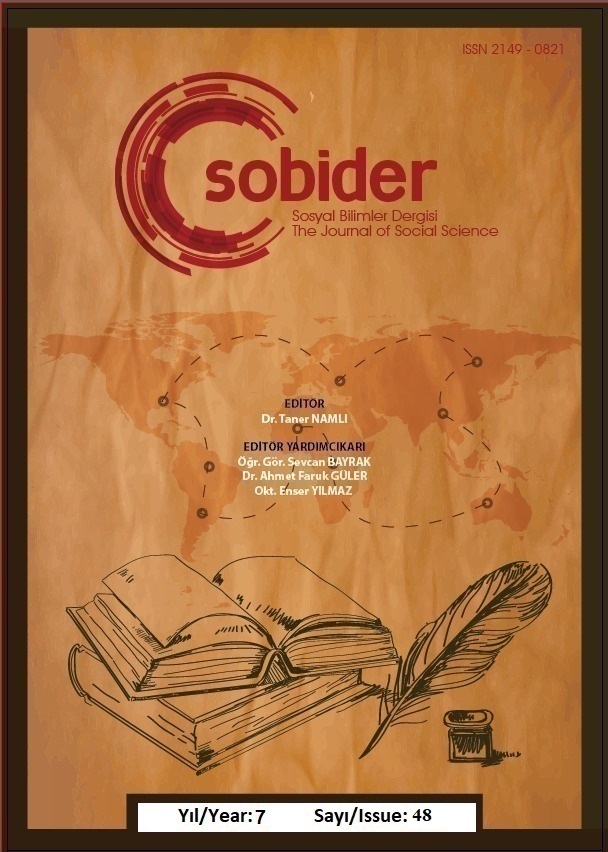Author :
Abstract
19. yy. sonlarından itibaren bestecilerin, net bir şablona sahip olan Sonat-Allegro formunun tonal alan hakimiyetini etkileyecek nitelikte modal veya dizisel yeni ses organizasyonları sergilemeye başladıkları görülmektedir. Modern İtalyan müziğinin öncü bestecilerinden Mario Pilati’nin, 1929 tarihli La Minör Viyolonsel Sonatı’nın ilk bölümünü (I. Moderato mosso) ele alan bu çalışma, aynı zamanda Sonat (veya Sonat-Allegro) formundaki söz konusu bölümün, analitik düzeydeki ilk incelemesidir. Çalışmada, geleneksel Sonat form şablonuna uygunluk derecesine odaklanılmış olan eser bölümü, öncelikle ton alanları ve materyallerin karakter farklılıkları gözetilerek temalarına ayrılmıştır. İkinci olarak ise eserin modern yaklaşımının ne şekilde gerçekleştirildiği irdelenmiş, bestecinin tonal armoninin alışıldık ses organizasyonlarının dışına çıkmak için hangi araçları ne şekilde ve ne yoğunlukta kullandığına açıklık getirilmeye çalışılmıştır. Analiz sonucunda; bestecinin, Sonat formuna genel hatlarıyla sadık kaldığı ve tüm tematik alanları tonal bir çerçevede sergilediği görülmüş, bölümde yoğun bir şekilde yer alan modal ve benzeri yapıdaki dizileri ise formun köprü ve Gelişme gibi stabil olmayan bölmelerinde kullandığı tespit edilmiştir.
Keywords
Abstract
Starting from the end of the 19th century, it has been witnessed that the composers had begun to perform new pitch organizations based on scale or mode that would affect the dominance of the tonal zone. This study that examines the first movement (I. Moderato mosso) of Sonata in A minor for cello and piano (dating back to 1929) of Mario Pilati - one of the leading composers of modern Italian music- is also the first analytical research about this movement in Sonata form to examine the degree to which the movement is suitable for the traditional Sonata form. At first, the movement was divided into the themes by considering the tonal areas, and the diversity of the materials. Thus, the degree to which the movement is suitable for the traditional Sonata Form was examined. Secondly, it was analyzed that how the modern approach for the movement was put into practice and which tools the composer applied in what intensity to get out of common sound structures of tonal harmony. As a consequence of the analysis, it is seen that the composer kept to the general features of the Sonata Form, and exhibited all the thematic zones in a tonal function. On the other hand, it is spotted that the composer used modes and various scales in the non-stable parts such as transition and Development of the form.
Keywords
- Bennett, R. (1995). Music Dictionary. New York: Cambridge University Press.
- Candela, D. (2017). Sonata in F minor for violin and piano; Preludio, Aria & Tarantella on Old Neapolitan Folk Tunes; Sonata in A minor for cello and piano. Chamber Music for Violin and Piano & Cello and Piano [Booklet] (s. 7-10). İtalya: Brilliant Classics.
- Caplin, W. E. (1998). Classical Form: A Theory of Formal Functions for the Instrumental Music of Haydn, Mozart, and Beethoven. New York: Oxford University Press.
- Carpenter, A. (2018). Scholarly Program Notes To Accompany A Graduate Flute Recital. Yüksek Lisans tezi, Southern Illinois University, Illinois. Erişim: 30 Mayıs 2020, Southern Illinois University: https://opensiuc.lib.siu.edu/cgi/viewcontent.cgi?article=2200&context=gs_rp
- Earle, B. (2014). Mario Pilati, Preludio, Aria e Tarantella. Erişim: 17 Mayıs 2020, Musikproduktion Höflich: https://repertoire-explorer.musikmph.de/wpcontent/uploads/vorworte_prefaces/1570.pdf
- Gatti, G. M. (1978). L'opera di Gian Francesco Malipiero. Erişim: 21. Mayıs 2020, https://www.rodoni.ch/marcellosorcekeller/malipieromskeller.html
- Gorlinski, V. (2009). Hexatonic Scale. Erişim: 25 Haziran 2020, Encyclopædia Britannica: https://www.britannica.com/art/hexatonic-scale
- Hepokoski, J. (2010). Sonata Theory and Dialogic Form. P. Bergé (Ed.). Musical Form, Forms & Formenlehre (s. 71-89). Leuven: Leuven University Press.
- Karadeniz, İ. ve Şahin, N. (2020). Around the World in 80 Hours: Reintroduction of Modality to Western Classical Music. U. Aslan, A. Keleş ve E. Ergene (Ed.). III. Uluslararası Müzik ve Dans Araştırmaları Sempozyumu: 17-20 Ekim 2018, Sempozyum Bildirileri (s. 77-92). Trabzon: Trabzon Üniversitesi Yayınları.
- Leeuw, T. D. (2005). Music of the Twentieth Century (S. Taylor, Çev). Amsterdam: Amsterdam University Press. (1964)
- Masterson, S. E. (2011). Approaches to Sonata Form in Mid-Twentieth-Century American Piano Sonatas. Doktora tezi, Connecticut Üniversitesi, Storrs. Erişim: 17 Mayıs 2020, https://opencommons.uconn.edu/dissertations/AAI3504798/
- Monsaingeon, B. (1989). Of Mozart and Related Matters: Glenn Gould in Conversation with Bruno Monsaingeon. T. Page (Ed.). The Glenn Gould Reader (s. 32-43). New York: Alfred A. Knopf.
- Morgan, R. P. (1991). Twentieth-Century Music / A History of Musical Style in Modern Europe and America. New York & London: W. W. Norton & Company.
- Pearsall, E. (2012). Twentieth-Century Music Theory and Practice. New York & London: Routledge.
- Pilati, M. (2008). Concerto for Orchestra. [T. Nemec, Adriano, Slovak Radio Symphony Orchestra]. Concerto for Orchestra / Suite for Strings and Piano [CD]. Almanya: Naxos. (2000)
- Rodoni, L. (2004). Italian Music During the Fascist Period. R. Illiano (Ed.). I Rapporti D’arte e D’amicizia Tra G. F. Malipiero e A. Lualdi Alla Luce di Alcune Lettere Inedite (s. 429547). Belçika: Brepols.
- Rosen, C. (1988). Sonata Forms. New York: W. W. Norton & Company.
- Susanni, P. ve Antokoletz, E. (2012). Music and Twentieth-Century Tonality. New York:





